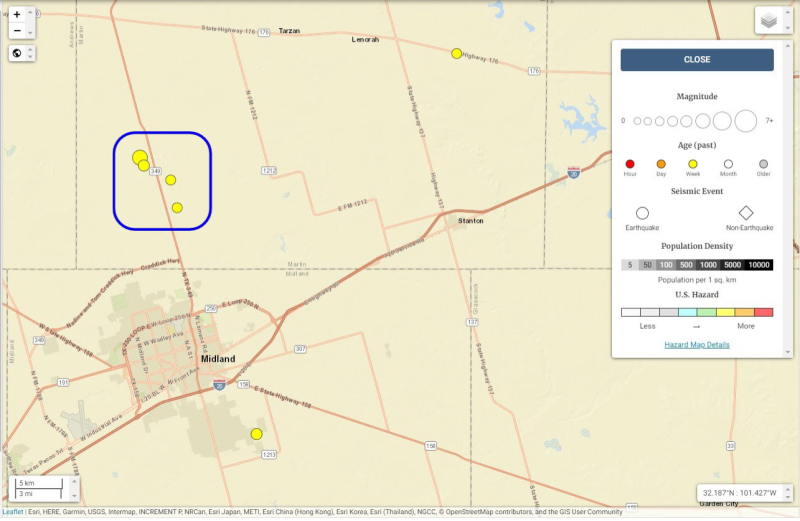A magnitude 5.3 earthquake—one of the strongest in Texas history—was felt widely across the Permian Basin of west Texas and south-eastern New Mexico on Friday, rattling homes and shaking windows.
The quake hit in Martin County at 5:35 p.m. local time with a depth of about 5 miles, about 12 miles north-northwest of Midland, Texas, according to the US Geological Survey.
A magnitude 3.3 aftershock, with a depth of about 4 miles, struck shortly after at 5:38 p.m. in the same area, followed by magnitudes 2.7 and 2.6 aftershocks about a mile south striking around 11:00 p.m.
These earthquakes struck on the 1-year anniversary of when a series of four earthquakes with magnitudes of 3.1, 3.6, 3.7, and 3.3 (in order of occurrence) occurred in northwest Martin County.
The area of seismic activity lies within the Gardendale Seismic Response Area (SRA) designated by the Railroad Commission of Texas (RRC), the regulatory authority for the state’s oil and gas development.
The commission on 17 December said it deployed inspectors to the area to examine produced water disposal activity at injection wellsites near the earthquake.
“In December 2021, the RRC ordered the indefinite suspension of all produced water disposal in deep injection wells in the SRA. Staff will review permit requirements for other injection wells in the area as it prepares for a response to reduce the frequency and intensity of earthquakes,” the regulator said in a release.
The Gardendale SRA spans an area of about 100 square miles of four Midland Basin counties (Andrews, Ector, Martin, and Midland). Seismic activity in the area prompted the RRC at the end 2021 to shut down deep saltwater disposal sites that inject saltwater at depths of 10,000 ft below the surface.
Todd Staples, president of the Texas Oil & Gas Association, said in a statement that industry operators continue to cooperate with the RRC in response to the recent activity in the Gardendale SRA.
"The RRC inspection of injection wellsites in the area is appropriate and should inform, along with industry data, the best next steps forward and direct actions beyond currently adopted protocols,” he said. “Reducing injection volumes, targeted shut-in of injection wells, expanding the size of the SRA, and comprehensive data collection and analysis are all available tools. Scientific data confirms that some continued seismicity activity often occurs after an event like the one that occurred Friday evening."
The Gardendale SRA is one of three in the Permian Basin currently under close monitoring. After a swarm of earthquakes shook the small town of Stanton, Texas, located between Midland and Big Spring, the RRC designated the region around Stanton as an SRA.
Following a magnitude 5.4 earthquake that struck in mid-November in the Northern Culberson-Reeves SRA, the RRC implemented a revised response plan. The regulators expanded the SRA from 2,366 to 2,601 square miles to include more disposal wells and amended the plan to further reduce injection volumes.
"Operators have committed to meeting the original deep disposal volume target of 298,000 BPWD three months early and meeting a new target of 162,000 BWPD by June 30, 2023. This represents a 68% drop in disposal volume compared to January 2022 before the plan went into effect," the agency said in November, noting that the potential lag time between changes in injection rates and changes in seismicity varies, with historical activity indicating a potential lag time of 12–18 months.
There were no immediate reports of damage or injuries, with residents reporting feeling the earthquake as far north as Lubbock and as far west as Roswell, New Mexico.
